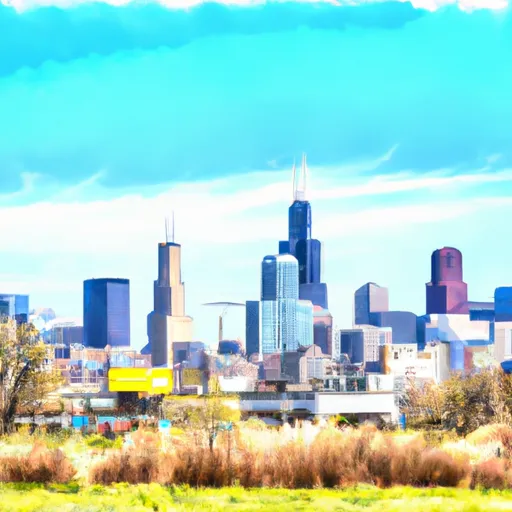-
 Snoflo Premium
Snoflo Premium
Get unlimited access to all our content
With no Ad interruptions! - Start Your Free Trial Login with existing account
West-Chicago
Eden Index
Climate
7.6
•
Recreation
4.6
•
Community
3.8
•
Safeguard
5.6/10

West Chicago is a vibrant city located in DuPage County, Illinois. It has a favorable climate, with warm summers and cold winters. Summers are typically mild, with average temperatures ranging from 70°F to 85°F, while winters are cold with temperatures ranging from 15°F to 35°F. The city experiences moderate rainfall throughout the year.
West Chicago is home to several natural water bodies, including the West Branch DuPage River and St. Joseph's Creek. These hydrology constituents provide scenic beauty and recreational opportunities. Fishing and canoeing are popular activities along the rivers, allowing residents and visitors to enjoy the peacefulness of nature.
Outdoor enthusiasts can explore the numerous parks and trails in and around West Chicago. The Reed-Keppler Park offers various amenities, including playgrounds, picnic areas, and sports fields. The Prairie Path is a popular trail for walking, jogging, and biking, providing a scenic route through nature. The West Chicago Prairie Forest Preserve is another notable outdoor space, offering hiking trails, bird-watching opportunities, and an educational center to learn about the local ecosystem.
Overall, West Chicago's favorable climate, hydrology constituents, and outdoor recreation opportunities make it an ideal destination for nature lovers and those seeking active outdoor pursuits.
What is the Eden Index?
The Snoflo Eden Index serves as a comprehensive rating system for regions, evaluating their desirability through a holistic assessment of climate health, outdoor recreation opportunities, and natural disaster risk, acknowledging the profound impact of these factors on livability and well-being.
Climate Health Indicator (CHI): 7.6
West-Chicago receives approximately
949mm of rain per year,
with humidity levels near 83%
and air temperatures averaging around
10°C.
West-Chicago has a plant hardyness factor of
5, meaning
plants and agriculture in this region thrive during a short period during spring and early summer. Most
plants will die off during the colder winter months.
By considering the ideal temperature range, reliable water supplies, clean air, and stable seasonal rain or snowpacks, the Climate Health Indicator (CHI) underscores the significance of a healthy climate as the foundation for quality living.
A healthy climate is paramount for ensuring a high quality of life and livability in a region, fostering both physical well-being and environmental harmony. This can be characterized by ideal temperatures, reliable access to water supplies, clean air, and consistent seasonal rain or snowpacks.
Weather Forecast
Streamflow Conditions
Upper Illinois
Area Rivers
Upper Illinois
Snowpack Depths
Upper Illinois
Reservoir Storage Capacity
Upper Illinois
Groundwater Levels
Recreational Opportunity Index (ROI): 4.6
The Recreational Opportunity Index (ROI) recognizes the value of outdoor recreational options, such as parks, hiking trails, camping sites, and fishing spots, while acknowledging that climate plays a pivotal role in ensuring the comfort and consistency of these experiences.
Access to outdoor recreational opportunities, encompassing activities such as parks, hiking, camping, and fishing, is crucial for overall well-being, and the climate plays a pivotal role in enabling and enhancing these experiences, ensuring that individuals can engage in nature-based activities comfortably and consistently.
Camping Areas
| Campground | Campsites | Reservations | Toilets | Showers | Elevation |
|---|---|---|---|---|---|
| Beech Bend | None | 373 ft | |||
| Gibson City Park | 4 | 731 ft | |||
| Mousetail Landing State Park | 24 | 429 ft | |||
| Rushing Creek - LBL | 56 | 402 ft | |||
| Fox Ridge State Park | 45 | 728 ft | |||
| Piney - LBL | 300 | 385 ft | |||
| Paris Landing State Park | 63 | 392 ft | |||
| Natchez Trace State Park | 50 | 637 ft | |||
| Sam Parr State Park | 80 | 524 ft | |||
| Boswell Landing | 34 | 406 ft |
Nearby Ski Areas
Catastrophe Safeguard Index (CSI):
The Catastrophe Safeguard Index (CSI) recognizes that natural disaster risk, encompassing floods, fires, hurricanes, and tornadoes, can drastically affect safety and the overall appeal of an area.
The level of natural disaster risk in a region significantly affects safety and the overall livability, with climate change amplifying these risks by potentially increasing the frequency and intensity of events like floods, fires, hurricanes, and tornadoes, thereby posing substantial challenges to community resilience and well-being.
Community Resilience Indicator (CRI): 3.8
The Community Resilience Indicator (CRI) recognizes that education, healthcare, and socioeconomics are crucial to the well-being of a region. The CRI acknowledges the profound impact of these elements on residents' overall quality of life. By evaluating educational resources, healthcare accessibility, and economic inclusivity, the index captures the essential aspects that contribute to a thriving community, fostering resident satisfaction, equity, and social cohesion.

